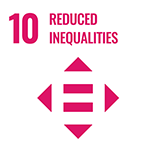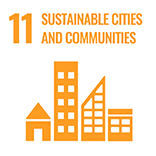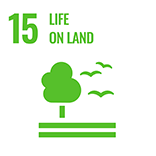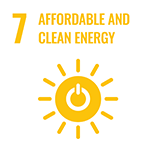Nature-based “carrots and sticks” solution

Summary
This nature-based solution focuses primarily on forest conservation through effectively enforced monitoring and management to minimize deforestation in the Wolong Nature Reserve, China.
The “carrots and sticks” solution is a nature-based solution carried out in China, at the upstream tributaries of the Yangtze River in the Wolong Nature Reserve (WNR), a flagship protected area home to the largest population of wild giant panda, and a global hotspot for biodiversity where hazards such as earthquakes, floods and landslides are recurrent. It was part of the Natural Forest Conservation Program (NFCP), a large-scale national program aiming to reduce natural disaster risk by restoring ecosystems upstream of major rivers.
In the reserve, the NFCP program focused primarily on forest conservation through effectively enforced monitoring and management to minimize deforestation, targeting all the 120,500 ha forest (and shrub) land. The forest land was divided into parcels of varying sizes and about one third of the total area (40,100 ha), mostly those relatively near the main road of the WNR, was allocated to be monitored by local communities. This was carried out with a forest management concession contract that financially rewarded households for monitoring illegal logging in designated areas (“carrots”) and sanctioned households (either singularly or collectively) if illegal logging took place (“sticks”), with sanctions ranging from a small payment reduction up to the household being removed from the system. Moreover, limited use rights (e.g., collecting tree branches and dead trees) were also granted to concessionaires, in this case local household groups, township forest stations, and others. The rest of the NFCP area, mostly further away from roading, was allocated to be monitored by professional forest guards (mainly from the Department of Natural Resources Management (DNRM), conservation stations, and township level forest stations), supported by the Wolong Forest Police Squad that was later established in 2002. To monitor results, intensive semi-annual evaluations are conducted by the DNRM, associated local government and village committee actors at the end of the second and fourth quarters of each year before payment.
Overview
- Location:
- Implementation sites:
-
- Single country
- Single location
- Mountain region:
-
Qionglai Mountains in Western Sichuan province, a part of the Hengduan Mountain Range
- Province:
-
- Sichuan Province
- Site locations:
-
Wolong Nature Reserve in the Wenchuan County of the Ngawa Tibetan Autonomous Prefecture
- Solution scale:
- Area Covered:
-
- 1205 km2
- Ecosystem type(s):
- Solution type(s):
- Other Solution(s) type(s):
-
- community collaboration
- Climate impact(s) addressed:
- Climate impact time-scale(s):
- Main benefit associated with the solution:
- Co-benefit(s) associated with the solution implementation:
- Implementation timeline:
-
- 2001 - 2010
Solution details
Main beneficiaries & outcomes
Local communities were the main beneficiaries through the reduction of natural disasters risk as well as the increased economic and general well-being that resulted from the subsidy payment.
The benefits were widely available for almost all households in the ethics minority communities, with elderly households (without labourers for monitoring forests) also receiving a partial subsidy with monitoring duties. Later in the second round of the program in the 2010s, all individuals were included in the program with a higher level of per capita subsidy.
Planning and implementation
The project planning and implementation involved a wide range of stakeholder groups, including public administrators (mainly), public scientific and technical organizations, universities and village committees. Still, the main responsibility was with the inter-departmental Planning and Coordination Committee (led by one deputy director of Wolong National Nature Reserve Administrative Bureau (WNNRAB) and coordinated by the Department of Natural Resources (DNRM).
Relevant activities for implementation:
• Mid-2000: land and forest resources survey and mapping, and satellite image based forest map of the reserve created by Forest Inventory and Planning Institute of Sichuan Province, providing necessary spatial information.
• November 2000: Program’s official initiation with the formation of the NFCP Planning and Coordination Committee whose first decision was to allocate a major part of the budget to fund monitoring and management activities by local communities.
• Beginning 2001: Planning and pilots, as well as community consultation, spatial planning, monitoring area delineation with local households.
• July 2001: Program’s full implementation.
The Sichuan Department of Forestry (SDF), to whom WNR reports directly, officially monitors and evaluates the effectiveness of the project implementation. Both the SDF and WNR were supported by scientific and technical organizations and other expert communities, such as government institutes, domestic and international universities (e.g., Chinese Academy of Sciences, Peking University, Sichuan College of Forestry), international universities (e.g., Michigan State University), and international organizations (e.g., WWF China).
Finance
The program in the Wolong reserve received substantial funding, including but not limited to large sums directly from State Forestry Administration (SFA) through its Center for Natural Forestry Conservation and Management, in the way of subsidy. ~350,000 EUR/Year (1 EUR = 7.4 Yuan in 2001) were received for the first round (2001-2010) and ~1.15 Million EUR/year for the second (2011- 2020), however, this last amount was increased to ~2.3 Million EUR/year by 2017. No information is available regarding cost-benefit analysis being conducted.
On the other hand, an important indirect funding source was the revenue from small hydropower plants owned and operated by a local public company, one of which was specifically built and finished in 2001, with funding from SFA. To further facilitate the switch from fuelwood to electricity, thus reducing the pressure on forests, a local electricity subsidy was devised, a 25% reduction (from 0.04 USD per kilowatt-hour to 0.01) was applied for all local household electricity use (Wolong Administration Bureau, 2004). Additional government funds were also secured to update the rural electricity network to ensure the stability of electricity supply.
Innovation
The major innovation of the project was the introduction of a forest management concession contractual system – the “carrot and stick approach” – for local households to monitor illegal logging while at the same time having limited use rights. Local households, often in groups, took the responsibility to monitor and ensure the integrity of designated forest parcels (mostly near the main road, thus prone to illegal extraction activities) in exchange for annual NFCP payment. This design turned most of those forests from open-access resources to group-managed common-pool resources.
Performance evaluation
Intensive semi-annual evaluations are conducted by the Department of Natural Resources Management, associated local government and village committee actors at the end of the second and fourth quarters of each year before payment to evaluate performance of community monitoring.
At the same time, performance has also been evaluated by several external actors. For example, in previous studies, forest cover maps were developed for seven years: 1965, 1974, 1987, 1994, 1997, 2001 and 2007 to verify gains in vegetation cover (Vina et al., 2011, Yang et al., 2013). Equally, field survey and advanced spatial modelling was used to confirm gains in wildlife habitat (quantity and connectivity), wildlife populations, and biodiversity in general (Liu, 2012, Tuanmu et al., 2015). And in 2019, the program’s results were also analysed by in-depth interviews with selected stakeholders as part of a research study by the International Institute for Applied Systems Analysis (IIASA).
Long term project sustainability and maintenance
No information is available regarding environmental monitoring assessment being conducted. Still, it is known that the WNR performs regular wildlife survey assessments. Additionally, following the success of the program in the first two rounds, recently, China announced the ‘Natural Forest Conservation and Restoration Policy Plan’ (CCCPC & SC, 2019), a major update of the Natural Forest Conservation Program before the launch of its third period of ten years (2021- 2030).
Capacities for design and implementation
Knowledge
The rich knowledge of the core program’s team on forests and the complexities of conservation-development conflicts was fundamental for the effectiveness of the solution. Both the program’s committee chair, and the Department of Natural Resources Management’s director had solid science backgrounds and rich experience in working with local communities. Furthermore, to spread knowledge and awareness on the effects of deforestation and forest degradation for disaster risks among local communities was also important.
During the initiation, planning/design and implementation process, research on vegetation and ecosystems by local research teams and domestic and international partners helped enabling the program. Furthermore, technical support was provided by external research partners and epistemic community, as well as the Conservation and Research Center of Giant Pandas.
Technology
Technology can be considered one of the enablers for the program. Wolong was the first panda reserve where the new technologies of GPS, GIS and remote sensing were introduced by the Chinese Academy of Sciences and the WWF. In late 2000, the first state-of-art satellite image-based forest map for WNR was produced by the Forest Inventory and Planning Institute of Sichuan Province and provided necessary spatial information for the planning of the project.
Political / Legal
The implementation of the Natural Forest Conservation Program (NFCP) was part of a sequence of national policies on nature-based solutions established by the country’s government to address extreme hazard events. The strong political support for the program at the reserve was symbolized by the visit of Prime Minister Rongji ZHU during its initiation in 1999.
Additionally, other political/legal aspects functioned as pre-conditions that enabled the program. First, the existing mandate for the Wolong Special District Administrative Bureau, as a government body to protect communities from disaster risks. Likewise, the reserve’s special status as both a protected area with its own management body and as part of the local government with direct financial access to the State Forestry Administration, which gives it a unique level of independence in designing locally adaptive solutions. Finally, the provincial legislation to prevent illegal logging at the NFCP with increased monitoring capacity and enforcement efforts, including more strictly managed wood checkpoints.
Institutional
The program’s process in the reserve was characterized by close collaboration across hierarchical levels, from national and provincial to reserve level, and lower township, village, and groups. Most notable was the formation of the inter-departmental NFCP Planning and Coordination Committee, led by a deputy director of the National Nature Reserve Administrative Bureau (WNNRAB) and coordinated by the Department of Natural Resources Management (DNRM). This committee coordinated across departments, brokered scientific knowledge on NBS by commissioning independent evaluations and was instrumental in involving village households. Later, the cross-sectoral collaboration was strengthened by the introduction of the Wolong Forest Police Squad to add the necessary legal enforcement capacity.
Socio-cultural
The socio-cultural context was one of the major enablers of the solution given the level at which local communities were involved during the development and implementation processes.
During the initiation and planning period, small teams of Reserve staff, often led by Reserve-level officials or Department heads, visited all villages, meeting not only rural elites (e.g., village committees) but also local families. The feedback collected from these unprecedented consultations and pilot processes substantially shaped the final design of NFCP, and many rules in the NFCP forest management scoring system were decided and/or modified based on suggestions from local residents.
For the implementation, local households, often in groups, took the responsibility to monitor and ensure the integrity of designated forest parcels (mostly near the main road, thus prone to illegal extraction activities) in exchange for annual NFCP payment.
Outlook & Scalability
Barriers and adverse effects
● The membership in the program’s first round was on a household basis, and only households officially registered before June 30th of 2001 qualified. Moreover, household size was not considered in the subsidy payment design, and larger households raised this as an equity issue. What’s more, newly formed households were not included in the program after 2001 and by 2007, this had accumulated to >100 local non-NFCP households. Nevertheless, this problem was overcome in the second round of NFCP when the payment scheme was changed to be individual based, and every three years, all new-borns would be added as beneficiaries.
● To anticipate the stricter logging ban in 2000, many local households conducted a round of intensive logging in winter to stock enough wood for up to 5-10 years.
● Increased human-wildlife conflict because of uncompensated damage to crops and livestock from wildlife.
● The impact of the devastating 2008 earthquake cancelled out the NFCP achievements (Viña et al., 2011), and indirect impacts are still threatening lives and assets. The social and economic structure of local communities, including shared social norms, changed substantially during the post-quake construction. As more households switched to electricity and stopped raising pigs, the need to collect natural resources dropped. It was reported that household-based forest monitoring also declined after the earthquake (Yang et al., 2013b), as well as a result of more livelihood options (e.g., from tourism). Despite NFPC subsidy increases, for many local households, its relative percentage in total household income is declining.
Transformation and future outlook
Significant support for fundamental change results from reducing vulnerability by raising awareness and knowledge among local communities. For example, the reliance of local residents on forests for many generations changed since the implementation of the program, triggering not only environmental effects but also social, economic and cultural effects. Similarly, it was observed in past studies after NFCP, that tree harvest and hunting in local communities reduced and that there is a shift in the use of alternative energy sources (i.e., from fuelwood to electricity, Liu et al. 2016). Moreover, the solution itself uses nature to build resilience by restoring the forest and conserving natural ecosystems.
Additionally, the long-term monitoring efforts across the region assists in the learning-updating process to cope with climate related changes along time.
Potential for upscaling and replication
No information indicating the replication of the “carrots and sticks” solution is available. Nevertheless, the replication of similar Nature Based Solutions in other countries and regions, especially in the developing world would be desirable. For this to occur, and given the significant role of social norms and capacities for the success of this solution, the design of policies that better take into account active local social norms is considered a key advisable element.
Recently, China announced the ‘Natural Forest Conservation and Restoration Policy Plan’ (CCCPC & SC, 2019), which encourages strong public participation and the formulation of non-structural measures such as locally adapted rules for achieving sustainable forest management. The plan is a major update of the NFCP before the launch of its third period of ten years.
- Nature based solutions in-depth case study analysis of the characteristics of successful governance models
- The role of fairness normThe household-based natural forest conservation: The case of Wolong, China
- Effects of Natural Disasters on Conservation Policies: The Case of the 2008 Wenchuan Earthquake, China
- Performance and prospects of payments for ecosystem services programs: Evidence from China
- Nonlinear effects of group size on collective action and resource outcomes














Comments
There is no content